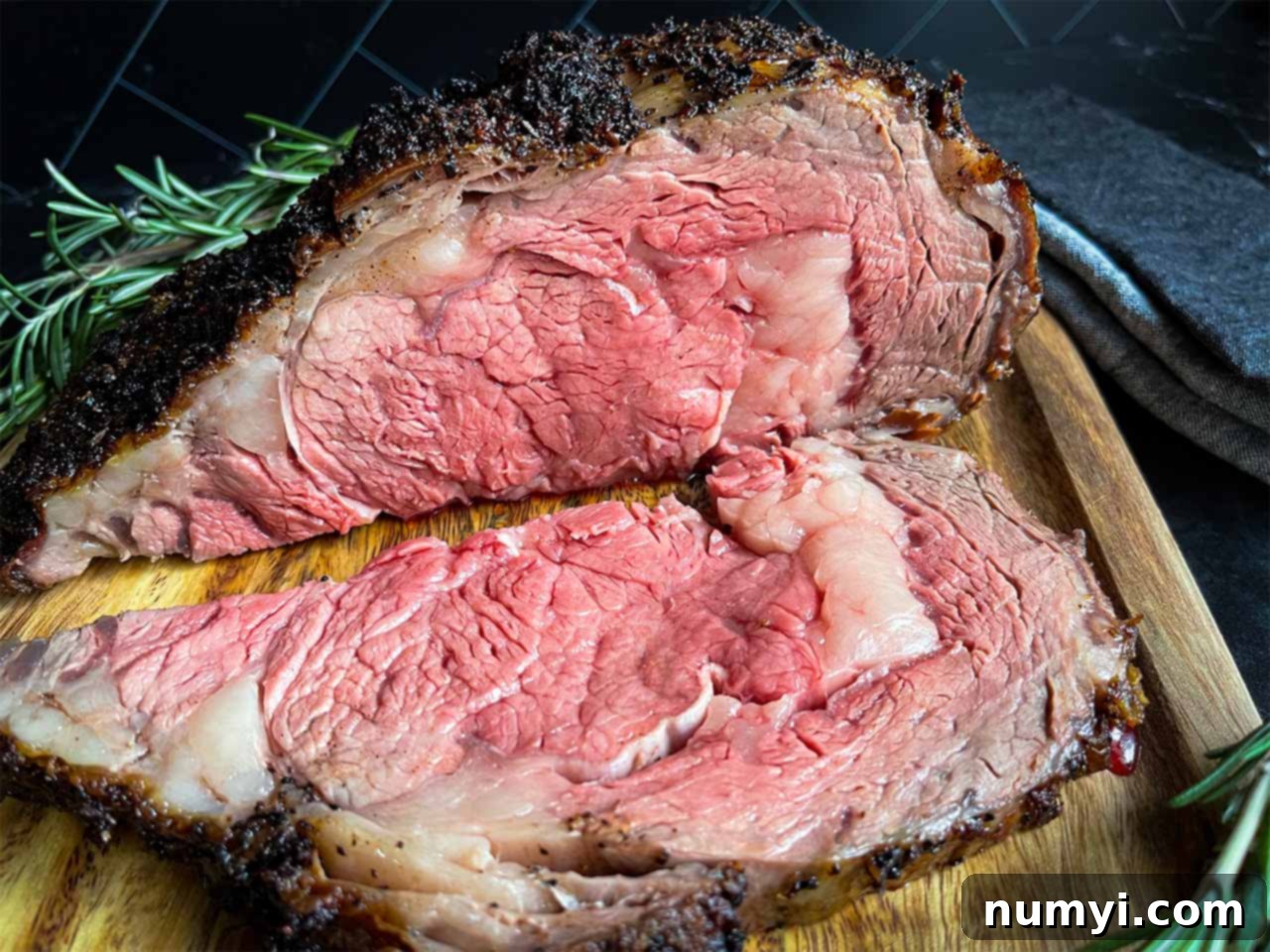Perfect Medium-Rare Prime Rib: The Foolproof 500-Degree Closed-Oven Method for Juicy, Tender Perfection
Dreaming of a holiday roast that’s perfectly medium-rare, incredibly juicy, and bursting with rich flavor? Many home cooks struggle to achieve that ideal doneness for prime rib, often ending up with an overcooked or unevenly cooked roast. If you’ve ever felt disappointed after spending good money on a beautiful cut of beef, you’re not alone. But what if there was a method that guaranteed flawless results every single time, turning you into a prime rib master?
Get ready to discover the renowned “500-Degree Closed-Oven Method,” a technique so simple yet so effective, it’s often called the “Foolproof Prime Rib” recipe. This approach promises a magnificent herb-butter crusted exterior and an unbelievably tender, rosy-pink interior. Say goodbye to guesswork and hello to the most delicious prime rib you’ve ever made!
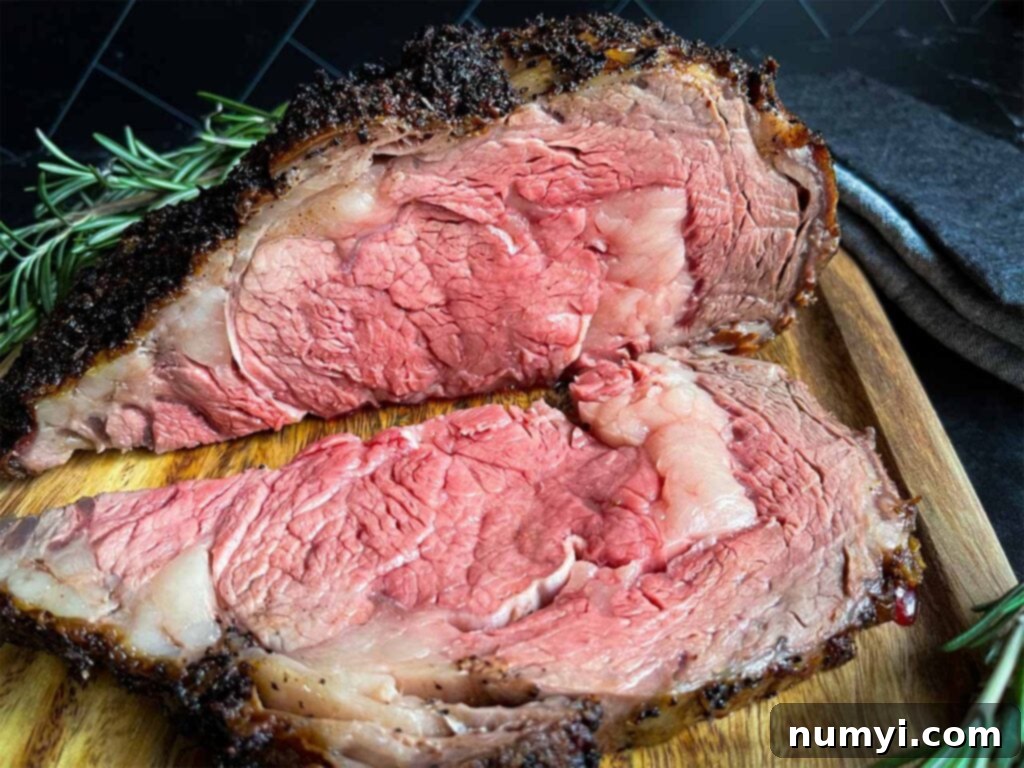
Why You’ll Love This Foolproof Prime Rib Recipe
For years, many home chefs have battled the daunting task of cooking a prime rib roast, often resulting in beef that was either dry, grey, or inconsistently cooked. When you invest in a prime piece of beef, especially for a special occasion or holiday dinner, perfection isn’t just desired – it’s expected. This ingenious method eliminates all the stress and delivers results that will impress even the most discerning palates.
- Guaranteed Medium-Rare Perfection: This technique consistently achieves a perfect medium-rare doneness throughout the roast, ensuring every slice is a succulent, rosy delight from edge to center.
- Incredible Herb-Butter Crust: The initial high-heat sear at 500°F creates a gorgeous, deeply browned, and flavorful crust. Infused with aromatic herbs, garlic, salt, and pepper, this crust locks in juices and adds an amazing textural contrast that elevates every bite.
- Effortless, Hands-Off Cooking: After the initial high-heat searing phase, the oven is simply turned off. The roast then cooks gently and passively with residual heat, requiring minimal active hands-on time and absolutely no constant monitoring. This ingenious approach frees you up to enjoy your guests, prepare other dishes, or simply relax.
- Unbelievably Juicy and Tender: The unique closed-oven approach ensures the meat retains its natural moisture content, resulting in an exceptionally tender and juicy roast that practically melts in your mouth. You’ll never experience a dry prime rib again.
- The Ultimate Showstopper for Special Occasions: Whether it’s Christmas dinner, a New Year’s Eve feast, a significant anniversary, or any celebratory gathering, a perfectly cooked prime rib is the quintessential showstopper. This method allows you to confidently serve a truly memorable and impressive meal without the usual kitchen anxiety.
This closed-oven method, popularized by culinary experts like Chef John from Food Wishes, brilliantly leverages residual heat to gently bring the roast to its ideal internal temperature. The powerful high-temperature sear initially creates that irresistible herb-butter crust, while the subsequent slow, passive cooking ensures even doneness from the outer edges to the very center. The result is a prime rib that’s not just cooked, but truly transformed into a masterpiece.
The final temperature of the prime rib, once it comes out of its prolonged, gentle oven rest, is delightfully warm, and when generously served with a rich au jus, each and every bite is simply an extraordinary experience. So, let’s dive into exactly how this culinary magic happens, step by meticulous step.
Pair Your Perfect Prime Rib with Delicious Side Dishes
A magnificent prime rib roast deserves equally exceptional accompaniments to complete your festive meal. Elevate your dining experience with some of our expertly crafted side dish recipes, perfectly chosen to complement the rich flavors of your beef:
- Creamy and rich Decadent Whipped Potatoes – a classic pairing that never disappoints.
- Flavorful Roasted Brussels Sprouts with Dipping Sauce – offering a delightful earthy crispness.
- Classic and comforting Easy Twice Baked Potatoes – a hearty and satisfying choice.
- A refreshing and bright Arugula Fennel Salad – to cut through the richness with a vibrant, peppery note.
- Hearty and earthy Roasted Green Beans and Mushrooms – a savory and tender vegetable medley.

Don’t Sweat The Recipe is supported by its readers. We may earn a commission if you purchase through a link on our site. Learn more.
What You’ll Need for Perfect Prime Rib
The true beauty of this prime rib recipe lies in its elegant simplicity. You won’t need a long list of exotic ingredients to create a show-stopping roast; instead, quality ingredients are paramount, allowing the natural, unparalleled richness of the beef to truly shine through.
- Prime Rib Roast: This is unequivocally the star of your holiday table. We highly recommend selecting a good quality, bone-in prime rib roast, ideally a USDA Prime or Choice cut, weighing approximately 5 to 7 pounds. The presence of the bones not only deepens the flavor profile but also provides crucial insulation, which promotes more even cooking throughout the roast. When selecting your roast, look for abundant marbling – those tiny, intricate streaks of fat distributed throughout the meat – as this is essential for achieving an incredibly juicy and flavorful outcome. As a general guide, plan for one rib bone per two people for generous portions, or about 1 to 1.5 pounds of meat per person. If possible, ask your butcher to “french” the bones (trim the meat off the ends for a cleaner presentation) and then tie the bones back onto the roast with butcher’s twine. This keeps the bones in place during cooking, contributing flavor, but makes carving much easier after it’s cooked.
- Unsalted Butter: Softened to room temperature, unsalted butter is a critical component for creating that desirable golden, savory crust. By using unsalted butter, you gain precise control over the overall saltiness of your roast, allowing the beef’s natural flavors to be enhanced without being overwhelmed.
- Fresh or Dried Rosemary: Rosemary is an iconic and classic herb pairing for beef, offering a wonderfully fragrant, pine-like aroma and a robust, earthy flavor. If you opt for fresh rosemary, ensure it is very finely chopped to ensure an even distribution across the roast. If using dried rosemary, make sure it’s high quality and crushed slightly between your fingers to release its potent aromatic oils.
- Kosher Salt: Distinct from regular table salt, kosher salt features larger, coarser crystals. This characteristic makes it significantly easier to sprinkle evenly over the meat and allows it to adhere better, promoting a more consistent seasoning. It also provides a cleaner, less harsh salty flavor, effectively pulling out the beef’s natural juices and intensifying its savory notes.
- Freshly Cracked Black Pepper: For the most vibrant and impactful flavor, always use freshly cracked black pepper. Pre-ground pepper can quickly lose its potency, aromatic complexity, and sharp bite. The robust, slightly spicy kick of fresh pepper beautifully complements and balances the inherent richness of the prime rib.
- Minced Garlic: Fresh garlic, finely minced, adds a pungent, savory, and aromatic depth to the herb-butter crust. As it roasts, the garlic caramelizes slightly, creating an irresistible aroma and a layer of complex flavor that permeates the exterior of the beef.
- Essential Tool: A Probe-Style Meat Thermometer: This is arguably the single most critical “ingredient” for guaranteed success with this particular cooking method. A reliable probe-style thermometer, designed to remain inserted in the roast throughout the entire cooking process and equipped with an alarm to alert you when a target temperature is reached, is absolutely indispensable. It ensures you achieve perfect doneness without ever needing to open the oven door.
Don’t Sweat The Recipe is supported by its readers. We may earn a commission if you purchase through a link on our site. Learn more.
How to Cook a Prime Rib Roast with the 500-Degree Method
This foolproof method streamlines the process of cooking prime rib into a few distinct, yet critical, steps. It relies on precise timing and astute temperature management to consistently deliver a roast that’s cooked to utter perfection, ensuring a tender and juicy result every time.
Critical First Step: Bring the Prime Rib to Room Temperature
Before any roasting begins, it is absolutely paramount that your prime rib roast comes completely to room temperature. This preparatory step, while seemingly simple, profoundly impacts the final doneness and, crucially, the evenness of your roast. To achieve this, remove the prime rib from the refrigerator a generous 3 to 4 hours before you intend to place it in the oven. Simply set it on a clean countertop. This extended period allows the internal temperature of the entire mass of meat to rise uniformly. This is vital because if a cold roast goes into a hot oven, the outer layers will invariably overcook and dry out by the time the colder center reaches your desired temperature, leading to an undesirable gradient of doneness.
important note
This specific closed-oven method for cooking prime rib relies heavily on the residual heat expertly trapped within your oven to continue cooking the meat slowly and gently. If you happen to own a newer, highly efficient oven that is equipped with a powerful cooling fan that activates immediately after the oven is turned off, this precise technique might not work exactly as intended. Such fans are designed to dissipate heat very quickly, which would counteract the slow cooking process.
However, if you are still keen to leverage the benefits of the initial high-heat sear, you can easily adapt this method: once the high-heat roasting time (calculated by weight) is complete, instead of turning the oven completely off, reduce its temperature to a very low setting, such as 175-200 degrees F (80-95 degrees C). Continue cooking your roast at this low temperature until it reaches your desired internal temperature. Crucially, always monitor the internal temperature with a reliable probe-style meat thermometer. Pull the meat from the oven as soon as it hits your target temperature, even if the suggested 2-hour “resting” time isn’t fully elapsed, to prevent any risk of overcooking.
The 500-Degree Rule Prime Rib Method Explained
This truly revolutionary cooking method for prime rib has garnered several popular aliases over time, all of which underscore its remarkable simplicity and undeniable effectiveness in delivering consistently perfect results:
- Foolproof Prime Rib: A name it earned because it virtually eliminates common cooking errors.
- Prime Rib 500 Rule: Directly referencing the critical initial high oven temperature.
- Prime Rib 500 Degrees: Another straightforward nod to the initial cooking heat.
- No Peek Method: Emphasizing the absolute necessity of not opening the oven door during the crucial resting phase.
- Closed Oven Method: Describing how the roast finishes cooking gently within a sealed, gradually cooling oven.
- Oven Off Method: Highlighting the unique cooking process where the oven is turned off, yet still actively cooks the meat.
Let’s meticulously walk through the detailed steps required to execute this incredible method, ensuring your success:
- Prepare the Aromatic Herb Butter Rub: In a small, clean bowl, meticulously combine your softened unsalted butter with the finely minced garlic, your choice of dried or fresh rosemary (finely chopped if fresh), kosher salt, and freshly cracked black pepper. Mix all these ingredients thoroughly until they are perfectly well incorporated, resulting in a fragrant and cohesive compound butter.
- Prepare the Roast for Seasoning: First and foremost, thoroughly pat the entire prime rib roast completely dry using paper towels. This is an absolutely crucial preparatory step, as a dry surface helps the compound butter adhere much better and, more importantly, promotes a superior, crispier, and more flavorful crust during the initial high-heat searing phase. Next, gently place the dried roast into a shallow roasting pan. If you’re using a bone-in roast, there’s no need for a separate roasting rack; the bones themselves act as a natural rack, effectively lifting the meat off the bottom of the pan and allowing essential heat to circulate evenly around it. However, if you’re working with a boneless roast, it’s highly advisable to place it on a V-rack or even a bed of roughly chopped aromatic vegetables (like onions and carrots) to ensure proper air circulation underneath.
- Generously Apply the Flavorful Crust: With a pastry brush or your hands, generously brush or rub the meticulously prepared herb butter mixture all over the prime rib roast. Concentrate on thoroughly covering the fat cap and all exposed meat surfaces. Don’t overly concern yourself with attempting to cover the bones themselves, as the meat is precisely where you desire that delectable, crispy crust to form and infuse its flavors.
- Insert the Indispensable Meat Thermometer: Regardless of which prime rib cooking method you choose, a reliable probe-style thermometer is, without a doubt, your best and most indispensable kitchen ally. Carefully insert the probe into the thickest part of the roast, being extremely cautious to ensure that it does not touch any bone, as bone proximity can lead to inaccurate readings. Set your thermometer’s alarm to 125°F (52°C) for a perfect medium-rare doneness. This vital tool allows you to continuously monitor the internal temperature without ever needing to open the oven door, a critical requirement for the success of this specific method.
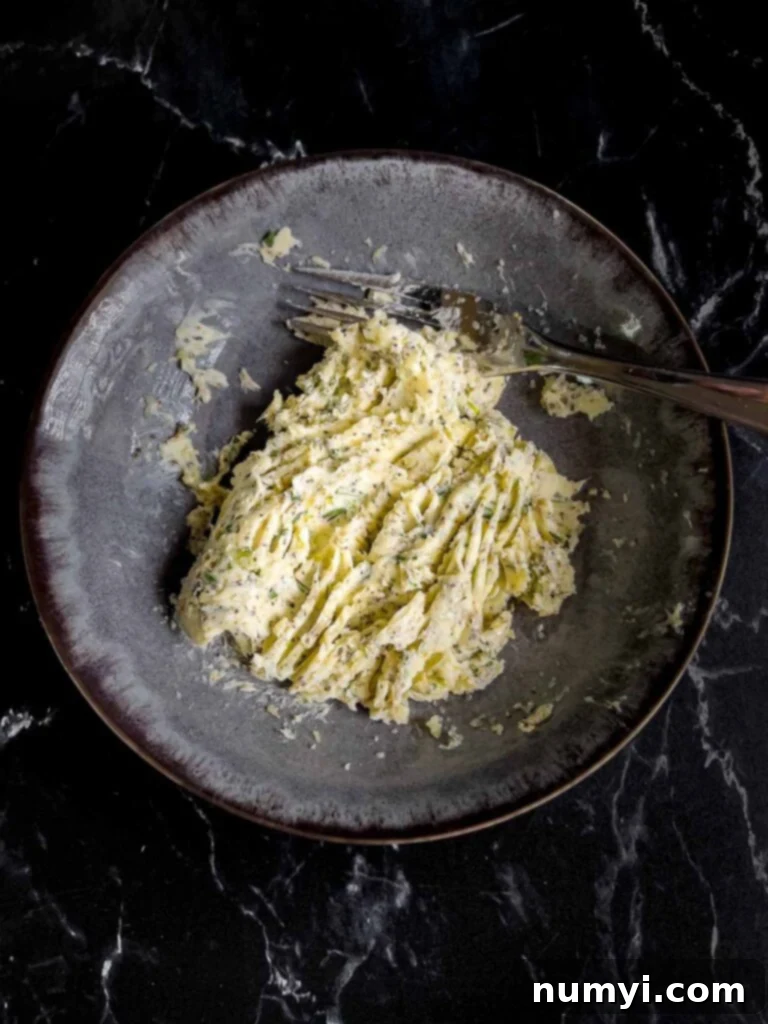

- Precisely Calculate High-Heat Roasting Time: This is where the core of the “500 Rule” derives its initial timing. Take the exact weight of your prime rib roast (measured in pounds) and multiply it by 5 minutes. This simple but precise calculation will yield the exact duration your roast needs to spend in the intensely hot oven for the initial searing phase. For instance, if your roast weighs 5.81 pounds, your calculation would be 5.81 x 5 = 29.05 minutes. Always round this result to the nearest whole number, so in this example, 29 minutes. Similarly, a 7-pound roast would require 7 x 5 = 35 minutes. It’s crucial to remember that this initial high-heat cooking time will vary directly based on the exact size and weight of your specific cut of meat.
- Execute the High-Heat Roast: Preheat your oven to a blazing 500 degrees F (260°C). It is absolutely essential to ensure your oven is fully preheated and has maintained this temperature for at least 15-20 minutes before you introduce the roast. Once the oven confidently reaches and holds this scorching temperature, carefully place the roasting pan, containing your perfectly prepared prime rib, into the center rack of the hot oven. Cook it for the precise, calculated number of minutes you determined in the previous step. This intense initial heat rapidly sears the exterior of the roast, creating that desirable, beautiful, and deeply flavored crust while effectively locking in the precious internal juices.
- The Critical “No Peek” Resting Period: The moment the calculated high-heat cooking time is completed, immediately and swiftly turn off your oven. Critically, set a timer for a full 2 hours, and under absolutely no circumstances should you OPEN THE OVEN DOOR FOR ANY REASON DURING THIS ENTIRE 2-HOUR PERIOD. This unwavering adherence to the “no peek” rule is paramount. The powerful residual heat expertly trapped within the sealed oven will continue to gently and slowly cook the prime rib. This passive cooking method steadily brings the roast to its perfect internal doneness without the risk of drying it out. This slow, controlled cooking phase is precisely what defines the “Foolproof” and stress-free aspect of this entire method, ensuring maximum tenderness and juiciness.
- Final Removal and Crucial Resting: After the entire 2 hours of “oven-off” cooking and resting, carefully remove the prime rib roast from the oven. It’s important to immediately transfer it out of the hot roasting pan to a clean cutting board. Even though it has already undergone a significant resting period in the cooling oven, a brief further rest of approximately 15-20 minutes on the countertop (loosely tented with aluminum foil if desired) is still beneficial. This additional resting time allows the muscle fibers to fully relax and the remaining internal juices to redistribute themselves evenly throughout the entire meat, ensuring that every single slice is as moist, tender, and flavorful as humanly possible. This extra rest is truly vital for achieving maximum juiciness and a superior texture.
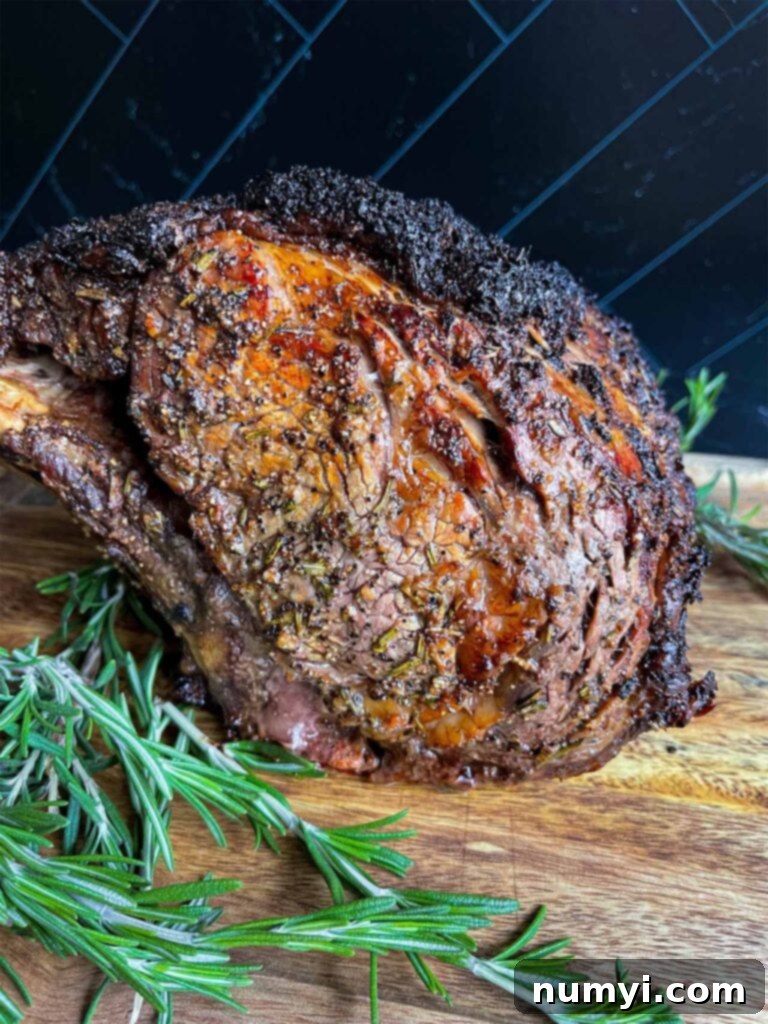
Expert Carving for Your Perfect Prime Rib
For the easiest and most elegant carving and serving experience, you may choose to remove the bones from the roast before you begin slicing. If you wisely asked your butcher to remove the bones and then tie them back on (a highly recommended practice for convenience), simply snip the butcher’s twine and gently pull the bones away from the cooked roast. They should detach quite easily. If the bones were not separated by your butcher, use a very sharp carving knife to carefully slice along the natural bone line, separating the main roast from the rib bones. These flavorful bones can then be saved and used to make an incredibly rich and delicious beef stock or a deeply savory gravy, adding another layer of culinary delight to your meal.
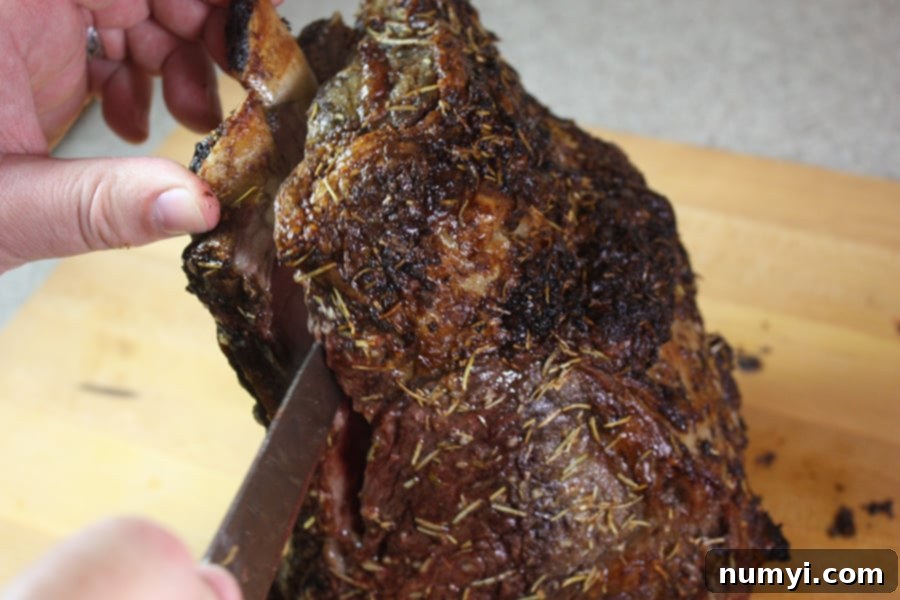
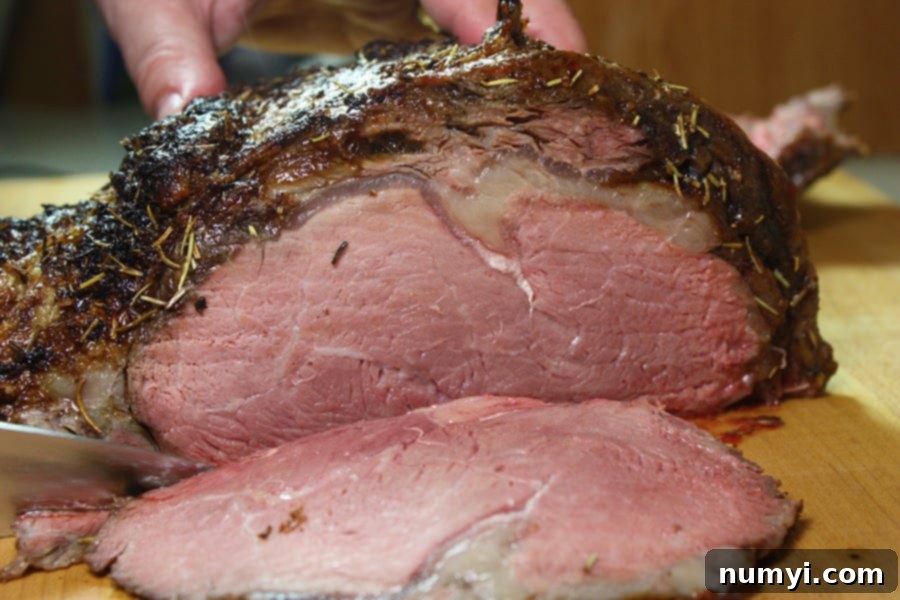
Just take a moment to admire that truly magnificent, perfectly cooked medium-rare prime rib! The deep, golden, and incredibly flavorful crust stands in beautiful contrast to the uniformly tender, juicy, and rosy interior. This visual perfection is a direct testament to the efficacy and brilliance of this incredible 500-degree closed-oven cooking method. Once the bones are removed, proceed to slice your prime rib against the grain into thick, impressive, and uniform portions. Slicing against the grain is key to maximizing tenderness.
Serve your stunning prime rib immediately with a generous side of the homemade au jus, which can be easily prepared from the rich pan drippings (detailed instructions are provided in the recipe card below). Prepare to be utterly impressed with your newfound culinary prowess and the sheer, unadulterated perfection of this show-stopping roast! Your guests will be asking for the secret to your success.
Prime Rib Temperature Guidelines for Your Preferred Doneness
Achieving your preferred level of doneness for prime rib is remarkably straightforward with the aid of a reliable meat thermometer. While the closed-oven method uniquely minimizes the effects of “carryover cooking” (the phenomenon where the internal temperature of meat continues to rise after it’s removed from the heat source), it’s still absolutely crucial to pull the roast at the precise moment. For this particular method, we typically aim for a slightly lower “pull temperature” because the gentle residual heat will continue to bring the roast to its final perfect doneness without any significant, unpredictable temperature spikes.
- Rare: For a cool, bright red center, pull your roast from the oven when its internal temperature reaches 115-120°F (46-49°C). The final resting temperature should be around 120-125°F (49-52°C).
- Medium-Rare: This is widely considered the ideal doneness for prime rib, offering a warm, perfectly pink center with maximum juiciness. Pull the roast when it hits 120-125°F (49-52°C). The final resting temperature will be approximately 125-130°F (52-54°C). We personally prefer pulling ours closer to 123°F for a beautiful rare-to-medium-rare outcome.
- Medium: If you prefer a warmer, uniformly pink center with slightly less red than medium-rare, pull the roast at 130-135°F (54-57°C). The final resting temperature will settle around 135-140°F (57-60°C).
- Medium-Well: For a roast with just a hint of pink remaining in the center, pull it at 140-145°F (60-63°C). The final temperature will be approximately 145-150°F (63-66°C).
- Well-Done: While it is possible to cook prime rib to well-done, we generally do not recommend cooking this premium cut past medium. Doing so tends to dry out the meat significantly and diminishes its inherent tenderness and rich, luxurious flavor.
Always remember, these are critical target temperatures. Your trusty probe thermometer is your most reliable guide for achieving prime rib perfection!
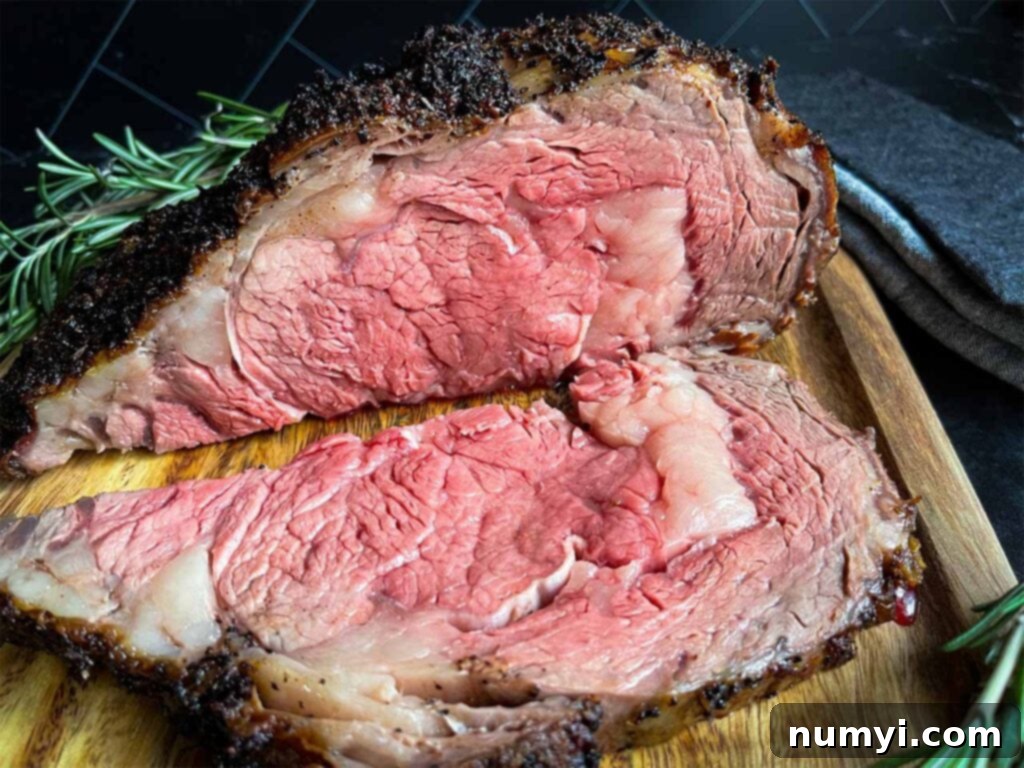
Expert Tips for the Best Prime Rib
To ensure your prime rib roast is nothing short of spectacular and truly lives up to its “foolproof” reputation, keep these crucial and insightful tips firmly in mind:
- Start with a Spotlessly Clean Oven: This tip is more critical than you might think! Since you will be cooking at an exceptionally high initial temperature (500°F), any accumulated drippings, grease, or food residue within your oven could easily burn, causing excessive smoke and filling your kitchen with an unpleasant odor. A clean oven prevents these potential distractions and hazards. As an added measure, you can place some sturdy root vegetables (like large carrots or chunks of potatoes) in the bottom of the roasting pan, beneath the prime rib. These act as a buffer, absorbing some of the drippings and helping to prevent the butter from burning and smoking excessively.
- Room Temperature is Non-Negotiable: We cannot stress this point enough because it is absolutely vital for consistent results. Allowing the prime rib to sit at room temperature for at least 3 to 4 hours (depending on size) before cooking ensures that the entire roast cooks evenly from edge to center. Skipping this step often leads to overcooked exterior and an undercooked, cold interior. Do not underestimate or skip this crucial preparatory phase!
- Line Your Roasting Pan for Easy Cleanup: For an incredibly effortless cleanup experience, generously line your roasting pan with heavy-duty aluminum foil before you even place the prime rib inside. This simple trick will save you a considerable amount of scrubbing and effort later on.
- Invest in and Trust Your Probe-Style Thermometer: This is, without a doubt, the single most important and indispensable tool for achieving success with this recipe. A reliable probe-style thermometer allows you to continuously monitor the internal temperature of the roast without the need to ever open the oven door. This constant monitoring is absolutely critical for the “closed oven” method to work effectively. Set the alarm to your desired pull temperature (e.g., 125°F for medium-rare). Remove the roast from the oven (and promptly out of the hot pan) the moment it reaches this target temperature, even if the 2-hour residual cooking time isn’t fully complete. Remember, we often pull ours around 123°F for that perfect rare-to-medium-rare outcome.
- Avoid Instant-Read Thermometers During Active Cooking: While instant-read thermometers are fantastic for quick spot-checks, they are not suitable for monitoring the cooking process with this method. They require you to repeatedly open the oven door, which releases crucial trapped heat and severely disrupts the carefully controlled “closed oven” environment. This will negatively impact the passive cooking process. Save your instant-read thermometer for a final, quick check just before carving.
- Monitor Temperature Acceleration Closely: Pay very close attention to your probe thermometer, especially as the roast’s internal temperature approaches its target. The internal temperature of large cuts of meat tends to accelerate more quickly towards the very end of the cooking process. Being vigilant will help you pull it at precisely the right moment.
- Understand the Variables Affecting Cook Time: It’s important to recognize that several factors can influence the total cooking time for this prime rib recipe. These include the exact size and starting (room) temperature of your particular roast, the accuracy and calibration of your specific oven’s thermostat, and how consistently your oven maintains its heat. Therefore, always trust the readings of your reliable probe thermometer above strict adherence to the clock.
- The Unwavering Importance of Resting: After carefully removing the roast from the oven (and promptly transferring it out of the hot pan), allow it to rest undisturbed for a minimum of 15 to 20 minutes, or even up to 30 minutes for exceptionally larger roasts. This crucial resting period is not merely a suggestion; it is essential. It allows the contracted muscle fibers of the meat to relax and, more importantly, permits the incredibly flavorful internal juices to redistribute themselves evenly throughout the entire roast. This prevents those precious juices from escaping when you slice it, ensuring every single bite is incredibly moist and flavorful.
- Don’t Forget the Au Jus: Those pan drippings at the bottom of your roasting pan are pure gold! Do not discard them. They are the perfect foundation for creating a rich, savory, and homemade au jus, which is the absolute quintessential accompaniment to your perfectly roasted prime rib.
Frequently Asked Questions About Prime Rib
A prime rib, often referred to as a standing rib roast, is a luxurious and highly prized cut of beef sourced from the primal rib section of a steer. It typically comprises several rib bones (ranging from 2 to 7) with the highly sought-after ribeye muscle attached. This cut is celebrated for its abundant intramuscular fat marbling, which contributes immensely to its exquisite tenderness, juiciness, and rich, beefy flavor during cooking. Prime rib can be purchased either bone-in or boneless. While boneless cuts offer convenience for carving, bone-in prime rib provides an additional layer of insulation, aiding in more even cooking, and imparts a deeper, richer flavor from the bone marrow. Many experienced cooks prefer to ask their butcher to “french” the bones (trimming the meat off the ends for a cleaner presentation) and then tie the bones back onto the roast with butcher’s twine. This preserves the benefits of bone-in cooking while significantly simplifying the carving process after the roast is cooked.
As a general and generous rule of thumb, you should plan for approximately 1 to 1.5 pounds of bone-in prime rib per person. If you’re purchasing a bone-in roast, another way to estimate is one rib bone for every two people, assuming you’re aiming for ample portions. For guests with lighter appetites or if you’re serving a wide array of substantial side dishes, you might get away with slightly less, around 0.75 pounds per person. However, it’s almost always preferable to have a little extra, especially for such a prized and desirable dish, as leftovers are delicious!
The terms “rib roast” and “prime rib” are quite often used interchangeably in common culinary language, but there can be subtle, important distinctions. “Prime Rib” technically refers to a standing rib roast that specifically comes from USDA “Prime” graded beef. The “Prime” grade is the highest quality classification for beef, indicating superior marbling, tenderness, and juiciness. However, the term “prime rib” has become so universally popular that it’s frequently used generically for any standing rib roast, regardless of its specific USDA grade (which could also be Choice or Select). A “rib roast,” on the other hand, is a broader, more general term that simply refers to the cut of meat from the rib section, irrespective of its USDA quality grade. Generally, a bone-in roast is accurately called a standing rib roast, while a boneless version might be labeled as a boneless ribeye roast or, indeed, boneless prime rib. In essence, while all “prime ribs” are technically “rib roasts,” not all “rib roasts” necessarily meet the stringent “Prime” grade classification.
For the specific 500-degree rule method outlined in this recipe, we cook the prime rib roast entirely uncovered. The initial, intense high-heat roasting phase is purposefully designed to create that beautiful, crispy, and deeply flavorful herb-butter crust on the exterior of the roast. Covering the roast during this critical stage would unfortunately steam the surface of the meat, which would prevent this desired crust from forming, resulting in a less appealing texture and flavor. The subsequent closed-oven resting period then gently finishes the cooking process without any need for a cover, ensuring optimal moisture retention and even heat distribution throughout.
Using this 500-degree rule recipe for an average 5-pound bone-in prime rib roast, the total active and passive cooking time (which includes both the initial high-heat roast and the subsequent 2-hour closed-oven resting period) will be approximately 2 hours and 25-30 minutes. This total accounts for the calculated high-heat time (e.g., a 5 lb roast multiplied by 5 minutes equals 25 minutes) plus the fixed 2 hours in the turned-off oven. It’s essential not to forget the crucial 3-4 hours of bringing the roast to room temperature before cooking, and an additional 15-20 minutes of resting after it’s finally removed from the oven and out of the hot pan. These pre and post-cooking steps are vital for the best results.
To properly store leftover prime rib and maintain its quality, first allow the roast to cool completely to room temperature. Once cooled, wrap it tightly in plastic wrap and/or aluminum foil, or place it securely in an airtight container. Stored this way, it will keep fresh in the refrigerator for up to 3-4 days. For reheating, the best approach is to do so gently to avoid drying out the meat. Slice off individual portions and reheat them slowly in a low oven (around 250°F / 120°C) until they are just warmed through. You can also gently reheat slices in a pan on the stovetop with a splash of beef broth to maintain moisture. Microwaving is generally not recommended for prime rib, as it can quickly make the meat tough and rubbery.
Absolutely! In fact, seasoning your prime rib in advance, a technique often referred to as a “dry brine,” can significantly enhance both its flavor and tenderness. For optimal results, generously apply the kosher salt and freshly ground black pepper to the entire roast 24 to 48 hours before you plan to cook it. After seasoning, leave it uncovered in the refrigerator (this allows the air to circulate and the surface to dry slightly, which contributes to a better crust). This extended period allows the salt to penetrate deeply into the meat, effectively breaking down muscle fibers and drawing moisture to the surface, which is then reabsorbed. This process results in a more thoroughly seasoned, incredibly tender, and juicier roast. When it’s finally time to cook, simply proceed with applying the herb butter mixture as directed in the recipe.
More Delicious Beef Recipes to Explore
If you’ve thoroughly enjoyed mastering this perfect prime rib recipe, be sure to explore these other fantastic and flavorful beef dishes from our kitchen. They are sure to become new favorites!
Garlic Herb Beef Top Round Roast
Roast Beef Sliders with Horseradish Sauce Recipe
Slow Cooker Corned Beef
Are you on Pinterest? Click the button below to add this recipe to one of your boards!
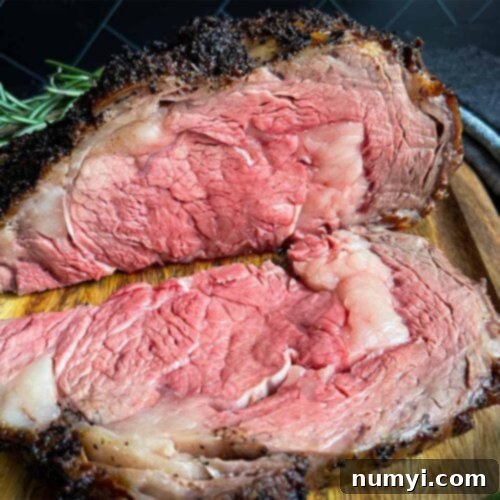
Prime Rib Roast Recipe
Print
Pin
Rate
Ingredients
- 5 lb bone-in prime rib roast
- 1/2 cup unsalted butter, softened
- 1 tablespoon freshly ground black pepper
- 1 tablespoon kosher salt
- 2 teaspoons dried rosemary (or 1 tbsp fresh, finely chopped)
- 3 cloves garlic, minced
For the Au Jus
- 1/4 cup beef fat and pan drippings (from roasting)
- 2 cups beef broth (low sodium preferred)
- Salt and freshly ground black pepper to taste
Instructions
Prime Rib Roast
-
The prime rib must come to room temperature before roasting. Remove it from the refrigerator and let it sit at room temperature for at least 3 hours. This step is crucial for even cooking.5 lb bone-in prime rib roast
-
Preheat your oven to a scorching 500°F (260°C). Ensure it’s fully preheated before proceeding.
-
In a small bowl, combine the softened unsalted butter, minced garlic, dried rosemary (or finely chopped fresh), kosher salt, and freshly ground black pepper. Mix well until a cohesive compound butter forms.1/2 cup unsalted butter, softened, 1 tablespoon freshly ground black pepper, 2 teaspoons dried rosemary (or 1 tbsp fresh, finely chopped), 3 cloves garlic, minced, 1 tablespoon kosher salt
-
Pat the prime rib roast completely dry with paper towels. Line a shallow roasting pan with aluminum foil for easier cleanup. Place the dried roast in the pan and spread the herb butter mixture generously and evenly over the top and sides of the prime rib.
-
Calculate your high-heat roasting time: Multiply the exact weight of your prime rib (in pounds) by 5 minutes. Round the result to the nearest whole minute. For example, a 5.81 lb roast would cook for 29 minutes (5.81 x 5 = 29.05).
-
Insert a probe-style meat thermometer into the thickest part of the roast, avoiding the bone. Set its alarm to your desired internal temperature (e.g., 125°F for medium-rare).
-
Place the roasting pan with the prime rib into the preheated 500°F oven. Roast for the exact amount of time you calculated in step 4.
-
Immediately after the high-heat roasting time is complete, turn off the oven. Crucially, DO NOT OPEN THE OVEN DOOR AT ALL for the next 2 hours. Let the roast cook with the residual heat.
-
After 2 hours in the closed, turned-off oven, remove the roast from the oven and carefully transfer it out of the hot roasting pan to a cutting board. Let it rest for an additional 15-20 minutes before carving.
Au Jus
-
While the roast is resting, place the roasting pan on a burner over medium-high heat. Carefully pour off all but about 1/4 cup of the beef fat and drippings.1/4 cup beef fat and pan drippings
-
Add the beef broth to the pan. Use a wooden spoon or spatula to scrape up all the flavorful browned bits from the bottom of the pan. Bring the mixture to a boil.2 cups beef broth (low sodium preferred), Salt and freshly ground black pepper to taste
-
Reduce the au jus to your preferred consistency and volume, aiming for about 1.5 cups or less for a concentrated flavor. Taste and adjust seasoning with salt and pepper as needed. Serve warm alongside your carved prime rib.
Notes
• A probe-style thermometer is essential. Insert it into the thickest part of the roast, avoiding bone.
• Pull the prime rib from the oven (and pan) when it reaches your desired internal temperature (e.g., 125°F for medium-rare), even if the 2-hour “oven-off” time is not fully complete. We often pull ours at 123°F for a perfect rare-to-medium-rare.
• Keep a close eye on the thermometer as the temperature tends to accelerate towards the end of the cooking process.
• Let the roast rest for at least 15-20 minutes after removing it from the oven and pan. This is critical for juicy results.
• Storing Leftovers: Place cooled prime rib in an airtight container and refrigerate for up to 3-4 days. For best results, reheat sliced portions gently in a low oven.
Nutrition
With this 500-degree closed-oven method, you’re not just cooking a prime rib; you’re mastering the art of creating a truly unforgettable culinary experience. The perfect medium-rare center, the crispy herb crust, and the incredible juiciness will make this recipe your go-to for all special occasions and a proud moment in your culinary journey. Happy roasting!
